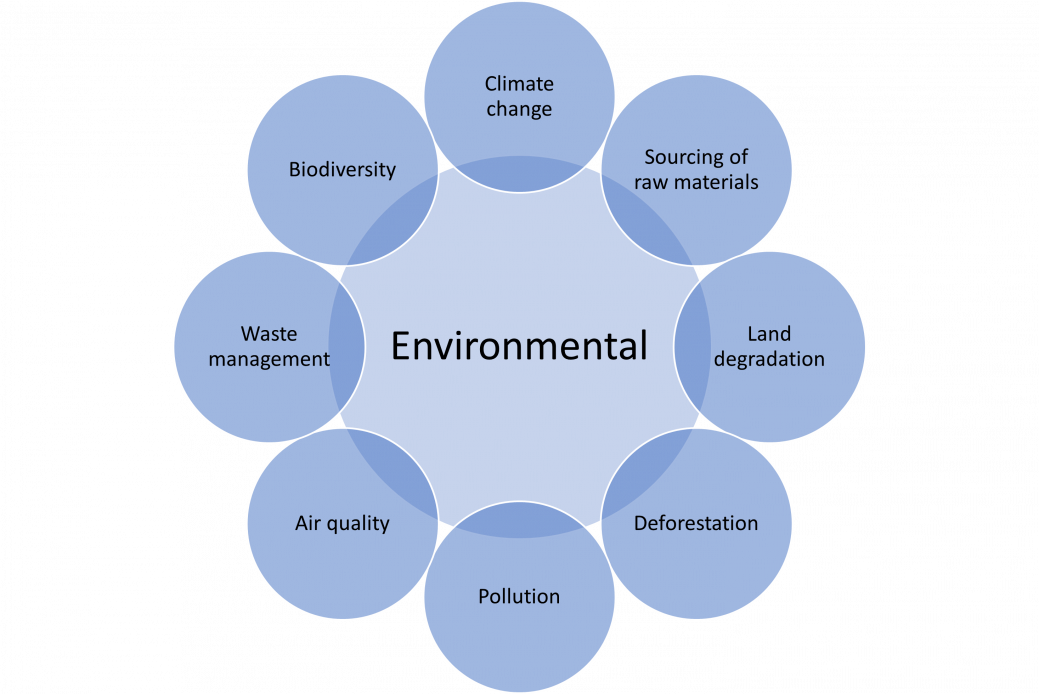This first story of the trilogy is aimed at laying some foundations about the concept, as well as unveiling the "E". Let´s start!
Why does ESG matter?
ESG-aligned objectives, initiatives and results provide many benefits for companies. Some of those advantages include increased business opportunities, creation of organisational and shared value, access to capital, compliance, future proofing, and brand reputation. Furthermore, enhanced risk management, talent attraction and engagement, and, above all, the conviction of doing the right thing and ensure sustainable development can be counted among the benefits.
Therefore, taking ESG seriously is essential, not only to safeguard the planet and our society for future generations, but also for organisations to future proof themselves. In the current ESG-focused culture, the companies that don’t embrace these aspects will fall behind and increasingly find themselves irrelevant.
What does the "E" entail?
The "E" of the ESG considers a company´s performance in relation to its stewardship towards the natural and physical environment. In this sense, it refers to both, the environmental aspects that affect an organisation, and the impacts that a company has on the environment.
In the image below, you can see some of the topics that fall into the environmental pillar of ESG:
Why is the "E" important for businesses?
The "E" factor is inextricably linked to companies´ impacts and efforts to stop climate change, which is also connected to the compelling need to reduce Green House Gas (GHG) emissions generated by their operations, but also throughout their entire value chain. This need has made relevant the distinction of three scopes that undertakings must assess, measure, control and reduce in order to contribute to both the planet health and sustainable development.
- Scope 1: direct emissions from a company´s owned or controlled sources, like the fuel burning when driving a firm´s vehicle or the production of GHG emissions due to on-site manufacturing.
- Scope 2: indirect emissions from the generation of purchased electricity, heating, steamed and cooling consumed by a company.
- Scope 3: all other indirect emissions originated in a company´s value chain. Some examples are purchased goods and services, waste generation and disposal, transportation and distribution, etc. For many businesses, scope 3 emissions account for more than 70% of their carbon footprint.
In the light of the negative impact that emissions cause, starting a path towards net zero is a compelling need and should be at the forefront of businesses efforts.
To successfully start this journey, companies need to understand the material impacts they have on the planet and society, identify risks and opportunities related to them and establish adequate KPIs (Key Performance Indicators) that allow them to tackle the identified challenges, impacts and opportunities.
Some sustainability and environmental-related KPIs that businesses use to contribute to positive change are the following:
- GHG emissions and carbon footprint: by measuring scopes 1, 2 and 3 emissions, companies can assess how they are directly or indirectly impacting climate change and the planet.
- Energy consumption and production: this accounts for an important proportion of GHG emissions.
- Waste reduction and recycling rates: companies benefit from monitoring their waste management to ensure that their production is sustainable, but also that the products themselves are recyclable and thus fit into a circular economy.
- Water consumption: water usage is becoming increasingly important due to the climate change effects on the water cycle, and water as a limited resource.
The "E" as a core value at Mazars in Denmark
Mazars in Denmark makes efforts to lead by example and live sustainably. Meet some of our colleagues and read about their daily sustainable practices.
Marie Gunni Bergh – Director
Marie implements many sustainable practices in her day-to-day life. Let’s look into some of these actions:
- Marie and her family, formed by four members, have chosen to air-dry their clothes. This action relates to the KPI about energy consumption and can lead to the reduction of her family´s carbon footprint by approximately 35 kg every month.
- At home, they sort the trash in order to be able to recycle it, which refers to the KPI about waste reduction and recycling rates. This reduces the need to extract raw materials and consume natural resources, thus protecting natural habitats. It also saves energy and avoids the air and water pollution derived from the extraction of materials, the use of energy and the burning process that products in the landfills are subjected to.
- Marie buys second-hand items most of the time, and she and her family donate or sell the clothes they no longer use, thus fostering the so crucial circular economy.
- At home, Marie´s family limit the showering time to 5 minutes to avoid water waste.
Mette Svendsen – Senior Manager
Mette is part of a family formed by two adults and a 19-year-old son that have tried to bring sustainability into their everyday life. These are some of their sustainable practices:
- 25 years ago, they built their own house already considering energy-saving measures. Thus, their house was built with IHC (Intelligent House Control), which makes it possible to control electrical installations via a PC or app. In addition to this, the hot water is heated by a heat pump which both utilizes the warm air in the house and ensures a good indoor climate.
- Moreover, 10 years ago, Mette´s family installed solar cells on the roof, which cover a large part of their electricity consumption: 58,8% of energy saved in 2021 and up to 93,8% of savings so far this year. Each individual solar panel's daily production and the total consumption of the day/week/year are registered in an app, thanks to which they can always keep track of when the solar panels produce enough power for them to use some appliances without consuming purchased energy.
- Furthermore, Mette´s family currently have two cars, both hybrids, which can probably lower their GHG emissions by approximately 45% compared to a fuel car.
- Regarding the water consumption, they have a large rainwater container for watering in the garden, which can almost cover their water needs for that purpose.
Linked to the KPIs related to the GHG emissions, the energy consumption and production, as well as the water consumption, there is no doubt that the above-described practices bring along a very high carbon footprint reduction; e.g. Mette´s family usually save between 30% and 40% of electricity every month due to these measures compared to a regular household.
Martin Kierkegaard – Senior
For Martin, making sustainable choices in our life is mandatory. He firmly believes that it is not too late to change our practices, and that no action is too small. That is why he implements several sustainability-aligned actions in his day-to-day life, the ones described here being mainly linked to the KPI on GHG emissions:
- Martin, like Marie, prefers using the bike. In this sense, for example, by biking four times a week between home and work, they are saving between 175 and 200 kg of CO2 per year.
- Most of the food he purchases is vegetarian, organic, and acquired in local shops when available. With this action, Martin is also contributing to lower the GHG emissions, since transportation of foreign food and cattle are major sources of methane, which, like other GHG, traps heat in the atmosphere. In fact, livestock emissions account for about one third of global methane emissions.
- The clothes he wears are mainly from a supplier with local production and high life-cycle expectancy. Hence, he is making his contribution to the decrease of the GHG emissions derived from massive and constant production, as well as from the transportation of clothes.
All in all, Martin states that "my small everyday actions of turning off unnecessary lights at home or cancelling advertising newspapers may seem immaterial but they are part of my conscious actions and are a reminder of the need to take care of our scarce resources and our environment".







